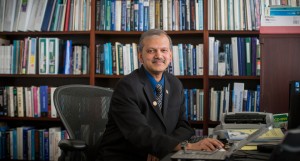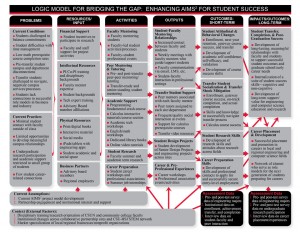CSUN STEM Program Receives Multi-Million-Dollar Grant from Feds

S.K. Ramesh, dean of CSUN’s College of Engineering and Computer Science. Photo by Lee Choo.
A collaborative effort by California State University, Northridge and local community colleges to increase the number of underrepresented students who study computer science and engineering has received the support of the U.S. Department of Education, awarding the program nearly $6 million over five years to expand its reach.
The project, AIMS2 — Attract, Inspire, Mentor and Support Students — has faculty at CSUN and the community colleges working together to ensure students, and now including incoming freshmen, have the support they need to graduate in a timely fashion.
“The program, which we started five years ago, was such a success that we now have a new grant to help us build on what we’ve done and expand our reach and the students we serve,” said S.K. Ramesh, dean of CSUN’s College of Engineering and Computer Science, who is leading the project as principal investigator of the grant.
The new grant is funded through a competitive program under the auspices of the HSI-STEM (Hispanic-Serving Institutions division) initiative of the U.S. Department of Education. CSUN will receive nearly $1.2 million in the first year, starting this year.
AIMS2 debuted in 2011 with the help of a similar grant from the department. At that time, it targeted Hispanic and low-income transfer students. The participating community colleges were Glendale Community College and College of the Canyons.
The goal was to increase the number of Hispanic and low-income students who graduated with degrees in computer science or engineering. Project leaders hoped to develop a model that could be replicated elsewhere. In its initial five years, about 240 students successfully completed the program and are now working in their chosen fields or pursuing graduate degrees.
“This new grant will enable us to double that number,” Ramesh said, noting that three additional community colleges joined the project — Los Angeles Pierce College, Moorpark College and Los Angeles Mission College — and that participation in AIMS2 has been extended to incoming freshmen.
Ramesh said a total of 12 campuses in the California State University system received similar grants. The campuses have agreed to share the best practices of their projects with colleagues in all campuses throughout the CSU system.
“We purposely designed AIMS2 so that it can be replicated,” Ramesh said. “If something works, it’s in all our best interests to share the model.”

The AIMS2 Logic Model
AIMS2 takes an interdisciplinary approach to ensure student success. Faculty and administrators from the participating community colleges and from CSUN’s College of Engineering and Computer Science, College of Mathematics and Science, and Michael D. Eisner College of Education are on the project team that meets monthly and monitors the needs of the students and how the project is responding to those needs. CSUN and community college faculty work together to ensure that students’ transition to the Northridge campus is as seamless as possible, including implementing summer bridge programs.
Students must apply to the program. The application process includes an essay about what they aspire to be, the challenges they face and how they see themselves succeeding.
Ramesh noted that in the past, nearly every applicant was accepted, “and even those who were not selected, we made sure that some of the services, such as tutoring, were available to them.”
Once accepted, students are placed in a cohort based on their discipline. Each cohort includes proactive academic advising and tracking, organized tutoring, peer and faculty mentoring, hands-on research opportunities and project-based learning, career advising, and support with the transition to the workforce or advanced studies.
The program was singled out in 2015 by the White House Initiative on Excellence for Hispanics in its “Bright Spot in Hispanic Education National Online Catalog.” In 2014, it received an honorable mention from Excelencia in Education as an example of excellence in the baccalaureate category.
“AIMS2 has the potential to significantly improve graduation rates and close the achievement gaps for Hispanic and low-income students, expand undergraduate research projects to mentor students, and enhance faculty collaboration between two-year and four-year institutions to improve student success,” Ramesh said. “We are humbled and thrilled to be selected, and look forward to serving larger numbers of students with the new grant award.”

 experience
experience